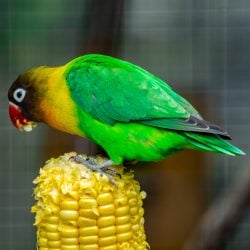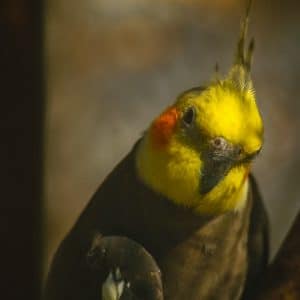Last Updated on by Mitch Rezman
Lovebirds are native to the African continent while the Gray-headed lovebird also known as the Madagascar lovebird comes from of all places, Madagascar. Lovebirds are known for their strong monogamous relationships and spend a lot of time being together wing to wing.
They are capable of having close relationships with people in addition to their chosen companion. They like to snuggle with people and quite often they will train their humans. You’re really better off spending short periods throughout the day with your lovebird rather than just one or two longer interactions, the way you would with a larger parrot. Lovebirds can be noisy but are not necessarily good talkers.
Lovebirds have been around as pets in the US since the early 20th century. Most Lovebirds are easy to keep as caged birds with the exception of the Lillian’s Lovebird and the Black Collared lovebird.
The Black Collared requires a certain type of fig so we don’t see a lot of those here in the US. Lovebirds are anywhere from 13 cm to 17 cm in length – about 5 inches – and weigh from 40 to 60 g (a little less than 2 ounces). The average lifespan of lovebirds is from 10 to 15 years.
Madagascar, Abyssinian, and Redhead lovebirds are sexually dimorphic. Peach-faced lovebirds are considered an intermediate species. Masked, Fishers, and Lillian’s (not seeing a lot in captivity because of difficulty in raising them) and Black Cheeked lovebirds are considered the white-eye-ring species.
Sometimes by watching how Lovebirds shred paper it’s possible to determine their sex. Boy lovebirds will make confetti when shredding newspaper, girl lovebirds will make strips and stuff them under their wings (this only works for mature lovebirds & is not very scientific but fairly accurate)
Peach face lovebirds also known as Rosy face lovebirds probably have the most mutations including Lutino, Pied Green, Aqua Turquoise, and Orange-face. If lovebirds of different species mate they will produce sterile hybrid offspring displaying the traits of both mom and dad. It’s recommended to place lovebirds of the same species or the same sex together for this reason.
Lovebird’s beaks are made of keratin which means their beaks grow continuously. It’s important to keep lots of toys available so they can chew as well as cuttlebones which help provide beak trimming and are a source of minerals. They require large cages or aviaries and play with the toys while hanging from the side of the cage which is important to keep in mind for proper bird toy placement.
Lovebirds are territorial and dominant by nature and don’t necessarily socialize well with other species including cats dogs other birds. They can be aggressive towards other birds and should not be housed with other species of birds in the same birdcage.
Until next time
Catherine Tobsing
President, Windy City Parrot, Inc.
Author Profile
Latest entries
 Bird BehaviorJune 26, 2025How is it Parrots Are Problem Solvers Social Animals and Even Use Tools?
Bird BehaviorJune 26, 2025How is it Parrots Are Problem Solvers Social Animals and Even Use Tools? Bird & Parrot AnatomyJune 25, 2025How a Tiny Chemical Modification Makes Parrots Nature’s Living Paintings
Bird & Parrot AnatomyJune 25, 2025How a Tiny Chemical Modification Makes Parrots Nature’s Living Paintings PigeonsJune 20, 2025How Do Parrots Thrive in Cities Outside Their Native Habitats?
PigeonsJune 20, 2025How Do Parrots Thrive in Cities Outside Their Native Habitats? Feeding Exotic BirdsJune 20, 2025Is Corn On the Cob Safe for Pet Birds?
Feeding Exotic BirdsJune 20, 2025Is Corn On the Cob Safe for Pet Birds?




smchapman2
19 Mar 2017Thanks so much for the lovebird info. And, yes, Blueberry has me trained.
WindyCityParrot
20 Mar 2017our pleasure smchapman2